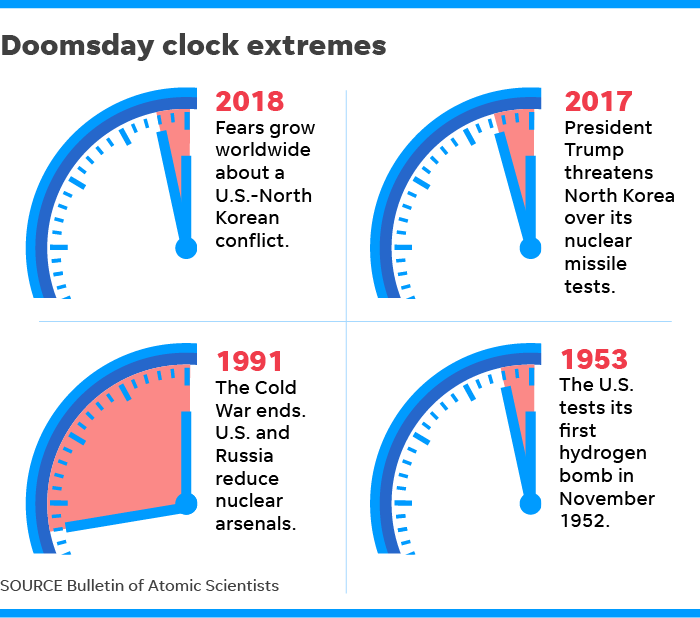Doomsday Clock
Since the beginning of time, people have speculated when the world is going to end. Even when there is relative peace across the globe and no outside threats are at bay, the question still weighs heavy on peoples’ minds. The ending of the world, often referred to as “Doomsday”, has been portrayed in countless films and TV shows. Each adaptation provides a theoretical and sometimes horrifying glimpse into Earth’s possible future. Though there have been passing fads that claim to know when the world will in fact end; recent years in particular were filled with these claims, there is no real timetable. Maybe there never will be. However, scientists theorize that the human race is moving itself closer and closer to the end of planet Earth.
In 1946, the Bulletin of Atomic Scientists (BAS) created the “Doomsday Clock”. On a normal clock, a day begins when the minute and hour hand strike twelve simultaneously. When the clock strikes twelve on the Doomsday clock, it means that BAS believe the world is about to end. Though there is a substantial amount of science and reason behind the movement of the hands on the clock, each fluctuation is not a cold, hard fact, but rather an educated opinion. As of 2018, the clock is set to 11:58, just two minutes away from midnight, or, in this context, dangerously close to the end of the world.
The clock’s time has changed 20 times since the BAS established it back in 1946. The BAS members were some of the first people to develop atomic weapons and have extensive knowledge of the difference between what is dangerous and what is world-ending. In its year of creation, the clock rested at 11:53, 7 minutes away from the supposed apocalypse. This number bobbled up and down for a while, before it peaked in 1953. This was the year that US tested the hydrogen bomb. At the time, this was among the most terrifying weapon tested, and it remains immensely lethal to this day. In 1953, the Doomsday clock read 11:58, but it didn’t stay there. By 1991, the clock had dropped 15 minutes to 11:43, the lowest it had ever gone. Obviously, times have since changed. The year of 2018 has matched the previous highest time, 11:58, and only time will tell if it will ever go back down.
But what attributed to spinning clock so far forward? First off, Trump’s election was a major contributing factor. Scientists working on the clock have little faith in Trump’s ability and see him in a vastly negative light. However, the BAS stated that their primary reason was that world leaders failed to respond to threats of nuclear war and ignored the potential atrocity of climate change. Causes of climate change, like the emission of greenhouses gases, are frequently trivialized by the public, but can have a potentially disastrous effect on the world. The possibility of nuclear warfare and weapons remain the biggest threat to the world. With so many conflicts between countries, the damage unleashed may be irreversible. Beyond these major reasons, the dramatic increase in the complexity of technology is cited as a potential breaking-point for doomsday. As computers grow more intricate and advanced, less human supervision is needed. Without an actual mind working behind the screen, the possibilities for a technological mistake can be fatal. Threats to the wellbeing of the world exist everywhere, and always will linger just enough to keep people on edge. However, how people respond to these prospects and fix them will determine the precious safety of the beloved Earth.





